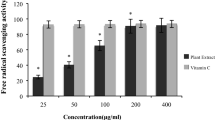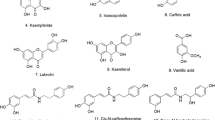Abstract
Previous studies demonstrated that the damaging action of absolute ethanol could be attributed to the enhancement in the reactive oxygen species, increase in lipid peroxidation and inhibition of antioxidative enzyme activity. In this study we investigated the mechanism of protective effect of olive leaf extract (OLE), a natural antioxidant, on gastric mucosal damage induced by absolute ethanol in rats. OLE (80 mg/kg daily) was applied intragastrically (i.g.) two weeks prior to absolute ethanol administration. Areas of gastric lesions were measured and ulcer index (UI) was calculated. The effects of applied OLE on gastric mucosal lesions, malondialdehyde level and antioxidative enzyme (catalase and superoxide dismutase) activity were compared with effects of i.g. pretreatment of reference drug, ranitidine (50 mg/kg). Absolute ethanol administration caused severe gastric mucosal haemorrhage. Pretreatment with OLE, as well as with ranitidine, significantly (p < 0.001) attenuated the gastric lesions induced. Furthermore, OLE was effective in the prevention of an increase in gastric lipid peroxidation and in the prevention of a decrease in antioxidative enzyme activity. The results obtained indicate that OLE has gastroprotective activity against ethanol-induced gastric lesions in rats, possibly related to its antioxidative properties.
Similar content being viewed by others
References
Gonzales M, Zarzuelo A, Gamez MJ et al (1992) Hypoglycemic activity of olive leaf. Planta Med 58:513–515
Al-Azzawie HF, Alhamdani MS (2006) Hypoglycemic and antioxidant effect of oleuropein in alloxan-diabetic rabbits. Life Sci 78:1371–1377
Khayyal MT, el-Ghazaly MA, Abdallah DM et al (2002) Blood pressure lowering effect of an olive leaf extract (Olea europaea) in L-NAME induced hypertension in rats. Arzneimittelforschung 52:797–802
Scheffler A, Rauwald HW, Kampa B et al (2008) Olea europaea leaf extract exerts L-type Ca(2+) channel antagonistic effects. J Ethnopharmacol 120:233–240
Somova LI, Shode FO, Mipando M (2004) Cardiotonic and antidysrhythmic effects of oleanolic and ursolic acids, methyl maslinate and uvaol. Phytomedicine 11:121–129
Wang L, Geng C, Jiang L et al (2008) The anti-atherosclerotic effect of olive leaf extract is related to suppressed inflammatory response in rabbits with experimental atherosclerosis. Eur J Nutr 47:235–243
Zarzuelo A, Duarte J, Jimenez J et al (1991) Vasodilator effect of olive leaf. Planta Med 57:417–419
Miljković D, Dekanski D, Miljkovi Ž et al (2009) Dry olive leaf extract ameliorates experimental autoimmune encephalomyelitis. Clin Nutr 28:346–350
Bisignano G, Tomaino A, Lo Cascio R et al (1999) On the in vitro antimicrobial activity of oleuropein and hydroxytyrosol. J Pharm Pharmacol 51:971–974
Furneri PM, Marino A, Saija A et al (2002) In vitro antimycoplasmal activity of oleuropein. Int J Antimicrob Agent 20:293–296
Markin D, Duek L, Berdicevsky I (2003) In vitro antimicrobial activity of olive leaves. Mycoses 46:132–136
Pereira AP, Ferreira IC, Marcelino F et al (2007) Phenolic compounds and antimicrobial activity of olive (Olea europaea L. Cv. Cobrançosa) leaves. Molecules 12:1153–1162
Sudjana AN, D’Orazio C, Ryan V et al (2009) Antimicrobial activity of commercial Olea europaea (olive) leaf extract. Int J Antimicrob Agents 33:461–463
Lee-Huang S, Zhang L, Huang PL, Chang YT (2003) Anti-HIV activity of olive leaf extract (OLE) and modulation of host cell gene expression by HIV-1 infection and OLE treatment. Biochem Biophys Res Commun 307:1029–1037
Micol V, Caturla N, Perez-Fons L et al (2005) The olive leaf extract exhibits antiviral activity against viral haemorrhagic septicaemia rhabdovirus (VHSV). Antiviral Res 66:129–136
Hamdi HK, Castellon R (2005) Oleuropein, a non-toxic olive iridoid, is an anti-tumor agent and cytoskeleton disruptor. Biochem Biophys Res Commun 334:769–778
Abaza L, Talorete TPN, Yamada P et al (2007) Induction of growth inhibition and differentiation of human leukemia HL-60 cells by Tunisian gerboui olive leaf extract. Biosci Biotechnol Biochem 71:1306–1312
Perrinjaquet-Moccetti T, Busjahn A, Schmidlin C et al (2008) Food supplementation with an olive (Olea europaea L.) leaf extract reduces blood pressure in borderline hypertensive monozygotic twins. Phytother Res 22:1239–1242
Meirinhos J, Silva BM, Valentao P et al (2005) Analysis and quantification of flavonoidic compounds from Portuguese olive (Olea europea L.) leaf cultivars. Nat Prod Res 68:189–195
Sánchez-Avila N, Priego-Capote F, Ruiz-Jiménez J, de Castro MD (2009) Fast and selective determination of triterpenic compounds in olive leaves by liquid chromatography-tandem mass spectrometry with multiple reaction monitoring after microwave-assisted extraction. Talanta 78:40–48
Speroni E, Guerra MC, Minghetti A et al (1998) Oleuropein evaluated in vitro and in vivo as an antioxidant. Phytother Res 12:98–100
Andreadou I, Iliodromitis EK, Mikros E et al (2006) The olive constituent oleuropein exhibits anti-ischemic, antioxidative, and hypolipidemic effects in anesthetized rabbits. J Nutr 136:2213–2219
Benavente-Garcia O, Castillo J, Lorente J et al (2000) Antioxidant activity of phenolics extracted from Olea europea L. leaves. Food Chem 68:457–462
Briante R, Paturni M, Terenziani S et al (2002) Olea europaea L. leaf extract and derivatives: antioxidant properties. J Agric Food Chem 50:4934–4940
Visioli F, Galli C, Bornet F et al (2000) Olive oil phenolics are dose-dependently absorbed in humans. FEBS Lett 468:159–160
Vissers MN, Zock PL, Roodenburg AJC et al (2002) Olive oil phenols are absorbed in humans. J Nutr 132:409–417
Visioli F, Poli A, Galli C (2002) Antioxidant and other biological activities of phenols from olives and olive oil. Med Res Rev 22:65–75
Kwiecien S, Brzozowski T, Konturek SJ (2002) Effects of reactive oxygen species action on gastric mucosa in various models of mucosal injury. J Physiol Pharmacol 53:39–50
Odabasoglu F, Halici Z, Cakir A et al (2008) Beneficial effects of vegetable oils (corn, olive and sunflower oils) and alpha-tocopherol on anti-inflammatory and gastrointestinal profiles of indomethacin in rats. Eur J Pharmacol 591:300–306
Dekanski D, Janićijević-Hudomal S, Ristić S et al (2009) Attenuation of cold restraint stress-induced gastric lesions by an olive leaf extract. Gen Physiol Biophys (in press)
Dekanski D, Janićijević-Hudomal S, Tadić V et al (2009) Phytochemical analysis and gastroprotective activity of an olive leaf extract. J Serb Chem Soc 74:367–377
Lowry OH, Rosenbrough NJ, Farr AL, Randall RJ (1951) Protein measurement with the Folin phenol reagent. J Biol Chem 193:265–275
Buege JA, Aust SD (1978) Microsomal lipid peroxidation. Methods Enzymol 52:302–310
Goth L (1991) A simple method for determination of serum catalase activity and revision of reference range. Clin Chim Acta 196:143–151
Misra HP, Fridovich I (1972) The role of superoxide anion in the autoxidation of epinephrine and a simple assay for superoxide dismutase. J Biol Chem 247:3170–3175
Rucker R, Storms D (2002) Interspecies comparison of micronutrient requirements: metabolic vs. absolute body size. J Nutr 132:2999–3000
Rucker RB (2007) Allometric scaling, metabolic body size and interspecies comparisons of basal nutritional requirements. J Anim Physiol Anim Nutr 91:148–156
Borelli F, Izzo AA (2000) The plant kingdom as a source of antiulcer remedies. Phytother Res 14:581–591
Olaleye SB, Farombi EO (2006) Attenuation of indomethacinand HCl/ethanol-induced oxidative gastric mucosa damage in rats by kolaviron, a natural biflavonoid of Garcinia kola seed. Phytother Res 20:14–20
Zayachkivska OS, Konturek SJ, Drozdowicz D et al (2005) Gastroprotective effects of flavonoids in plant extracts. J Physiol Pharmacol 56:219–231
Brzozowski T, Konturek PC, Drozdowicz D et al (2005) Grapefruit-seed extract attenuates ethanol-and stress-induced gastric lesions via activation of prostaglandin, nitric oxide and sensory nerve pathways. World J Gastroenterol 11:6450–6458
Romano M, Razandi M, Ivey KJ (1989) Effect of ranitidine on taurocholate-, ethanol-, and indomethacin-induced damage to gastric epithelial cells in vitro. Digestion 43:212–221
Manna C, Migliardi V, Golino P et al (2004) Oleuropein prevents oxidative myocardial injury induced by ischemia and reperfusion. J Nutr Biochem 15:461–466
Alarcon de la Lastra C, Martin MJ, Motilva V (1994) Antiulcer and gastroprotective effects of quercetin: a gross and histologic study. Pharmacology 48:56–62
Di Carlo G, Mascolo N, Izzo AA, Capasso F (1999) Flavonoids: old and new aspects of a class of natural therapeutic drugs. Life Sci 65:337–353
Martin MJ, La Casa C, Alarcon de la Lastra C et al (1998) Antioxidant mechanisms involved in gastroprotective effects of quercetin. Z Naturforsch (C) 53:82–88
Asuzu IU, Onu OU (1990) Anti-ulcer activity of the ethanolic extract of Combretum dolichopetalum root. Int J Crude Drug Res 28:27–32
Ramirez RO, Roa CC Jr (2003) The gastroprotective effect of tannins extracted from duhat (Syzygium cumini Skeels) bark on HCl/ethanol induced gastric mucosal injury in Sprague-Dawley rats. Clin Hemorheol Microcirc 29:253–261
Author information
Authors and Affiliations
Corresponding author
About this article
Cite this article
Dekanski, D., Ristić, S. & Mitrović, D.M. Antioxidant effect of dry olive (Olea europaea L.) leaf extract on ethanol-induced gastric lesions in rats. Mediterr J Nutr Metab 2, 205–211 (2009). https://doi.org/10.1007/s12349-009-0068-x
Received:
Accepted:
Published:
Issue Date:
DOI: https://doi.org/10.1007/s12349-009-0068-x




